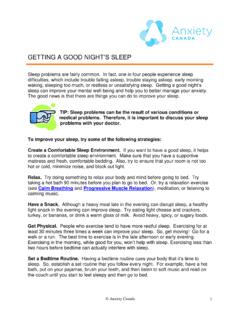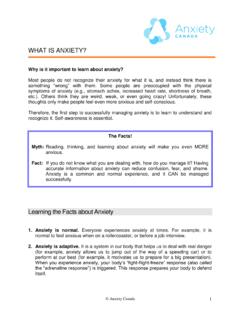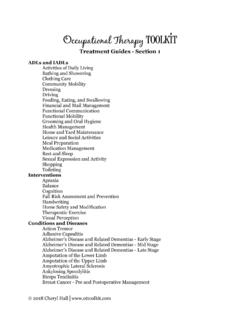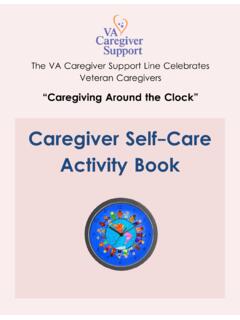Transcription of How to do Progressive Muscle Relaxation
1 Anxiety Canada 1 HOW TO DO Progressive Muscle Relaxation Progressive Muscle Relaxation teaches you how to relax your muscles through a two-step process. First, you systematically tense particular Muscle groups in your body, such as your neck and shoulders. Next, you release the tension and notice how your muscles feel when you relax them. This exercise will help you to lower your overall tension and stress levels, and help you relax when you are feeling anxious. It can also help reduce physical problems such as stomachaches and headaches, as well as improve your sleep. People with anxiety difficulties are often so tense throughout the day that they don t even recognize what being relaxed feels like.
2 Through practice you can learn to distinguish between the feelings of a tensed Muscle and a completely relaxed Muscle . Then, you can begin to cue this relaxed state at the first sign of the Muscle tension that accompanies your feelings of anxiety. By tensing and releasing, you learn not only what Relaxation feels like, but also to recognize when you are starting to get tense during the day. HELPFUL HINTS: Set aside about 15 minutes to complete this exercise. Find a place where you can complete this exercise without being disturbed. For the first week or two, practise this exercise twice a day until you get the hang of it.
3 The better you become at it, the quicker the Relaxation response will kick in when you really need it! You do not need to be feeling anxious when you practise this exercise. In fact, it is better to first practice it when you are calm. That way, it will be easier to do when feeling anxious. Getting ready Find a quiet, comfortable place to sit, then close your eyes and let your body go loose. A reclining armchair is ideal. You can lie down, but this will increase your chances of falling asleep. Although relaxing before bed can improve your sleep, the goal of this exercise is to learn to relax while awake.
4 Wear loose, comfortable clothing, and don t forget to remove your shoes. Take about five slow, deep breaths before you begin. Anxiety Canada 2 How To Do It The Tension Relaxation Response STEP ONE: Tension The first step is applying Muscle tension to a specific part of the body. This step is essentially the same regardless of which Muscle group you are targeting. First, focus on the target Muscle group, for example, your left hand. Next, take a slow, deep breath and squeeze the muscles as hard as you can for about 5 seconds. It is important to really feel the tension in the muscles , which may even cause a bit of discomfort or shaking.
5 In this instance, you would be making a tight fist with your left hand. It is easy to accidentally tense other surrounding muscles (for example, the shoulder or arm), so try to ONLY tense the muscles you are targeting. Isolating Muscle groups gets easier with practice. Be Careful! Take care not to hurt yourself while tensing your muscles . You should never feel intense or shooting pain while completing this exercise. Make the Muscle tension deliberate, yet gentle. If you have problems with pulled muscles , broken bones, or any medical issues that would hinder physical activity, consult your doctor first.
6 STEP TWO: Relaxing the Tense muscles This step involves quickly relaxing the tensed muscles . After about 5 seconds, let all the tightness flow out of the tensed muscles . Exhale as you do this step. You should feel the muscles become loose and limp, as the tension flows out. It is important to very deliberately focus on and notice the difference between the tension and Relaxation . This is the most important part of the whole exercise. Remain in this relaxed state for about 15 seconds, and then move on to the next Muscle group. Repeat the tension- Relaxation steps. After completing all of the Muscle groups, take some time to enjoy the deep state of Relaxation .
7 Note: It can take time to learn to relax the body and notice the difference between tension and Relaxation . At first, it can feel uncomfortable to be focusing on your body, but this can become quite enjoyable over time. 3 The Different Muscle Groups During this exercise, you will be working with almost all the major Muscle groups in your body. To make it easier to remember, start with your feet and systematically move up (or if you prefer, you can do it in the reverse order, from your forehead down to your feet). For example: Foot (curl your toes downward) Lower leg and foot (tighten your calf Muscle by pulling toes towards you) Entire leg (squeeze thigh muscles while doing above) (Repeat on other side of body) Hand (clench your fist) Entire right arm (tighten your biceps by drawing your forearm up towards your shoulder and make a Muscle , while clenching fist) (Repeat on other side of body) Buttocks (tighten by pulling your buttocks together) Stomach (suck your stomach in) Chest (tighten by taking a deep breath) neck and shoulders (raise your shoulders up to touch your ears)
8 Mouth (open your mouth wide enough to stretch the hinges of your jaw) Eyes (clench your eyelids tightly shut) Forehead (raise your eyebrows as far as you can) It can be helpful to listen to someone guide you through these steps. There are many Relaxation CDs for sale that will take you through a Progressive Muscle Relaxation (or something very similar). Alternatively, you can record a script of this process on a tape or CD, or ask a friend or relative with a calm, soothing voice to record it for you. It would sound something like this: Take a deep breath in through your your breath for a few now breathe another deep breath through your Now pay attention to your body and how it Start with your right squeeze all the muscles in your right foot.
9 Curl your toes as tight as you can, now hold relax and your foot go the difference between the tension and the tension flow out of your foo t like (then repeat with right lower leg and foot, entire right leg, ) Anxiety Canada Anxiety Canada 4 Quick Tense & Relax! Once you have become familiar with the tension and Relaxation technique, and have been practicing it for a couple weeks, you can begin to practise a very short version of Progressive Muscle Relaxation . In this approach, you learn how to tense larger groups of muscles , which takes even less time.
10 These Muscle groups are: 1. Lower limbs (feet and legs)2. Stomach and chest3. Arms, shoulders, and neck4. FaceSo instead of working with just one specific Muscle group at a time ( , your stomach), you can focus on the complete group (your stomach AND chest). You can start by focusing on your breathing during the tension and Relaxation . When doing this shortened version, it can be helpful to say a certain word or phrase to yourself as you slowly exhale (such as relax , let go , stay calm , peace it will pass ). This word or phrase will become associated with a relaxed state; eventually, saying this word alone can bring on a calm feeling.













